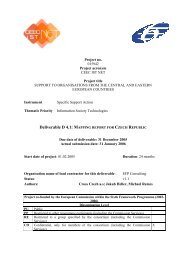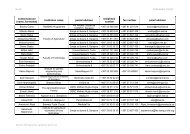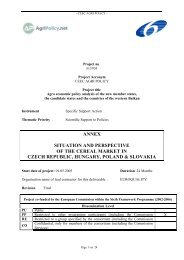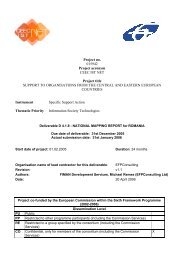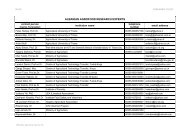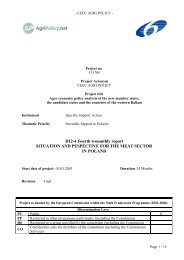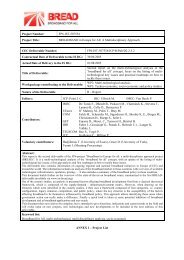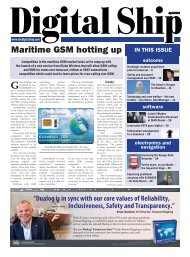- Page 1 and 2: Project Number: FP6-IST-507554 Proj
- Page 3 and 4: 1. Executive Summary Page 3 of 319
- Page 5 and 6: Page 5 of 319 FP6-IST-507554/JCP/R/
- Page 7 and 8: Page 7 of 319 FP6-IST-507554/JCP/R/
- Page 9 and 10: 3. List of abbreviations 3R Re-Ampl
- Page 11 and 12: PON Passive Optical Network PSD Pow
- Page 13 and 14: Page 13 of 319 FP6-IST-507554/JCP/R
- Page 15 and 16: Page 15 of 319 FP6-IST-507554/JCP/R
- Page 17 and 18: Page 17 of 319 FP6-IST-507554/JCP/R
- Page 19 and 20: 6.4 Convergence of markets 6.4.1 Ve
- Page 21 and 22: 6.4.6 Divergence of markets Page 21
- Page 23 and 24: Page 23 of 319 FP6-IST-507554/JCP/R
- Page 25 and 26: A/SP •Access to user •Security
- Page 27 and 28: 7.1 HOME NETWORK (wireless) 7.1.1 I
- Page 29 and 30: 7.1.2.1 Cabled Home Network Page 29
- Page 31 and 32: 7.1.3 Issues and Trends / Gap analy
- Page 33 and 34: Figure 6: Wireless technology roadm
- Page 35: SNI (Optical) Core Network PLC LT O
- Page 39 and 40: Page 39 of 319 FP6-IST-507554/JCP/R
- Page 41 and 42: Page 41 of 319 FP6-IST-507554/JCP/R
- Page 43 and 44: 7.2.2.3 Socio Economic issues Page
- Page 45 and 46: 7.2.2.5 Roadmap Page 45 of 319 FP6-
- Page 47 and 48: 7.2.3 Broadband Wireless Access 7.2
- Page 49 and 50: Page 49 of 319 FP6-IST-507554/JCP/R
- Page 51 and 52: 7.2.3.3 Socio Economic issues Page
- Page 53 and 54: 7.2.4 Mobile 7.2.4.1 Introduction P
- Page 55 and 56: 7.2.5 Satellite 7.2.5.1 Introductio
- Page 57 and 58: 7.2.5.3 Issues and trends Page 57 o
- Page 59 and 60: 7.2.6 xDSL 7.2.6.1 Current technolo
- Page 61 and 62: 7.2.7 FTTx 7.2.7.1 Introduction Pag
- Page 63 and 64: Page 63 of 319 FP6-IST-507554/JCP/R
- Page 65 and 66: Page 65 of 319 FP6-IST-507554/JCP/R
- Page 67 and 68: 7.2.8 DVB-T 7.2.8.1 Introduction: P
- Page 69 and 70: 7.2.9 HAP 7.2.9.1 Introduction Page
- Page 71 and 72: Page 71 of 319 FP6-IST-507554/JCP/R
- Page 73 and 74: 7.3.1.3 Socio Economic Issues Page
- Page 75 and 76: Page 75 of 319 FP6-IST-507554/JCP/R
- Page 77 and 78: Page 77 of 319 FP6-IST-507554/JCP/R
- Page 79 and 80: Page 79 of 319 FP6-IST-507554/JCP/R
- Page 81 and 82: Page 81 of 319 FP6-IST-507554/JCP/R
- Page 83 and 84: Page 83 of 319 FP6-IST-507554/JCP/R
- Page 85 and 86: 7.3.4 Signalling Page 85 of 319 FP6
- Page 87 and 88:
7.3.5.3 Issues and Trends Page 87 o
- Page 89 and 90:
7.3.6 Physical layer aspects 7.3.6.
- Page 91 and 92:
7.3.6.4 Key components of optical a
- Page 93 and 94:
Page 93 of 319 FP6-IST-507554/JCP/R
- Page 95 and 96:
7.3.7 Disturbance in PLC, Cable and
- Page 97 and 98:
7.4 CORE AND METRO 7.4.1 Optical Ne
- Page 99 and 100:
Page 99 of 319 FP6-IST-507554/JCP/R
- Page 101 and 102:
7.4.2.4.3 Roadmap summary The follo
- Page 103 and 104:
7.4.3 Optical Backbone 7.4.3.1 Intr
- Page 105 and 106:
OTN WDM SDH PDH Teleph 0.01 0.1 Pag
- Page 107 and 108:
7.4.3.2.2 Networking Page 107 of 31
- Page 109 and 110:
Page 109 of 319 FP6-IST-507554/JCP/
- Page 111 and 112:
Page 111 of 319 FP6-IST-507554/JCP/
- Page 113 and 114:
Page 113 of 319 FP6-IST-507554/JCP/
- Page 115 and 116:
7.4.4 Grid networks 7.4.4.1 Introdu
- Page 117 and 118:
Page 117 of 319 FP6-IST-507554/JCP/
- Page 119 and 120:
Page 119 of 319 FP6-IST-507554/JCP/
- Page 121 and 122:
Page 121 of 319 FP6-IST-507554/JCP/
- Page 123 and 124:
7.5.1.3 Issues and trends Page 123
- Page 125 and 126:
Page 125 of 319 FP6-IST-507554/JCP/
- Page 127 and 128:
Page 127 of 319 FP6-IST-507554/JCP/
- Page 129 and 130:
Page 129 of 319 FP6-IST-507554/JCP/
- Page 131 and 132:
Page 131 of 319 FP6-IST-507554/JCP/
- Page 133 and 134:
UMTS Nodes B & BTS FlexiNET Generic
- Page 135 and 136:
7.5.3.2 State of the art 7.5.3.2.1
- Page 137 and 138:
8. Market developments & policy asp
- Page 139 and 140:
Page 139 of 319 FP6-IST-507554/JCP/
- Page 141 and 142:
Page 141 of 319 FP6-IST-507554/JCP/
- Page 143 and 144:
8.2.3 Broadband policy Page 143 of
- Page 145 and 146:
Page 145 of 319 FP6-IST-507554/JCP/
- Page 147 and 148:
Page 147 of 319 FP6-IST-507554/JCP/
- Page 149 and 150:
8.4 Belgium 8.4.1 Introduction Page
- Page 151 and 152:
Page 151 of 319 FP6-IST-507554/JCP/
- Page 153 and 154:
8.6 Czech Republic 8.6.1 Introducti
- Page 155 and 156:
8.7 Denmark 8.7.1 Introduction Page
- Page 157 and 158:
Page 157 of 319 FP6-IST-507554/JCP/
- Page 159 and 160:
Page 159 of 319 FP6-IST-507554/JCP/
- Page 161 and 162:
Page 161 of 319 FP6-IST-507554/JCP/
- Page 163 and 164:
8.8 Estonia 8.8.1 Introduction Page
- Page 165 and 166:
8.9 Finland 8.9.1 Introduction Page
- Page 167 and 168:
Page 167 of 319 FP6-IST-507554/JCP/
- Page 169 and 170:
Page 169 of 319 FP6-IST-507554/JCP/
- Page 171 and 172:
Page 171 of 319 FP6-IST-507554/JCP/
- Page 173 and 174:
percent 120 100 80 60 40 20 0 Page
- Page 175 and 176:
percent of all Internet users in th
- Page 177 and 178:
8.9.3 Broadband policy Page 177 of
- Page 179 and 180:
Figure 62. FUNET Internet backbone.
- Page 181 and 182:
8.10 France 8.10.1 Introduction Pag
- Page 183 and 184:
Page 183 of 319 FP6-IST-507554/JCP/
- Page 185 and 186:
8.11 Germany 8.11.1 Introduction Pa
- Page 187 and 188:
Page 187 of 319 FP6-IST-507554/JCP/
- Page 189 and 190:
Page 189 of 319 FP6-IST-507554/JCP/
- Page 191 and 192:
8.12 Greece Page 191 of 319 FP6-IST
- Page 193 and 194:
Page 193 of 319 FP6-IST-507554/JCP/
- Page 195 and 196:
8.14 Ireland 8.14.1 Introduction Pa
- Page 197 and 198:
Page 197 of 319 FP6-IST-507554/JCP/
- Page 199 and 200:
Page 199 of 319 FP6-IST-507554/JCP/
- Page 201 and 202:
8.16.4 Conclusion Page 201 of 319 F
- Page 203 and 204:
8.17.4 Conclusion Page 203 of 319 F
- Page 205 and 206:
Page 205 of 319 FP6-IST-507554/JCP/
- Page 207 and 208:
TV SURF (the cable offer of EPT in
- Page 209 and 210:
8.19 Malta 8.19.1 Introduction Page
- Page 211 and 212:
8.20 Poland 8.20.1 Introduction Pag
- Page 213 and 214:
8.21 Portugal 8.21.1 Introduction P
- Page 215 and 216:
8.22 Slovakia 8.22.1 Introduction P
- Page 217 and 218:
8.23 Slovenia 8.23.1 Introduction P
- Page 219 and 220:
8.24 Spain 8.24.1 Introduction Page
- Page 221 and 222:
8.24.3 Broadband policy Page 221 of
- Page 223 and 224:
Page 223 of 319 FP6-IST-507554/JCP/
- Page 225 and 226:
Page 225 of 319 FP6-IST-507554/JCP/
- Page 227 and 228:
8.25.4 Appendix Page 227 of 319 FP6
- Page 229 and 230:
8.26.2.2 Pricing Company Access typ
- Page 231 and 232:
Page 231 of 319 FP6-IST-507554/JCP/
- Page 233 and 234:
Page 233 of 319 FP6-IST-507554/JCP/
- Page 235 and 236:
Tiscali Broadband x10 £15.99 512Kb
- Page 237 and 238:
BT Business Single 500 £35.24 512K
- Page 239 and 240:
15 12 9 6 3 0 2001 Q3 Q4 2002 Q1 Q2
- Page 241 and 242:
Figure 77: Broadband At Home Page 2
- Page 243 and 244:
Page 243 of 319 FP6-IST-507554/JCP/
- Page 245 and 246:
8.28.2.4 Pricing Figure 81: Home BB
- Page 247 and 248:
Page 247 of 319 FP6-IST-507554/JCP/
- Page 249 and 250:
Page 249 of 319 FP6-IST-507554/JCP/
- Page 251 and 252:
Page 251 of 319 FP6-IST-507554/JCP/
- Page 253 and 254:
Page 253 of 319 FP6-IST-507554/JCP/
- Page 255 and 256:
Page 255 of 319 FP6-IST-507554/JCP/
- Page 257 and 258:
8.29.2.2 Content Page 257 of 319 FP
- Page 259 and 260:
Page 259 of 319 FP6-IST-507554/JCP/
- Page 261 and 262:
Page 261 of 319 FP6-IST-507554/JCP/
- Page 263 and 264:
8.30 Non-EU country studies: South
- Page 265 and 266:
Page 265 of 319 FP6-IST-507554/JCP/
- Page 267 and 268:
Page 267 of 319 FP6-IST-507554/JCP/
- Page 269 and 270:
Page 269 of 319 FP6-IST-507554/JCP/
- Page 271 and 272:
Page 271 of 319 FP6-IST-507554/JCP/
- Page 273 and 274:
Page 273 of 319 FP6-IST-507554/JCP/
- Page 275 and 276:
Page 275 of 319 FP6-IST-507554/JCP/
- Page 277 and 278:
Page 277 of 319 FP6-IST-507554/JCP/
- Page 279 and 280:
Page 279 of 319 FP6-IST-507554/JCP/
- Page 281 and 282:
Page 281 of 319 FP6-IST-507554/JCP/
- Page 283 and 284:
8.30.5 Annex: Broadband diffusion f
- Page 285 and 286:
Page 285 of 319 FP6-IST-507554/JCP/
- Page 287 and 288:
Page 287 of 319 FP6-IST-507554/JCP/
- Page 289 and 290:
Page 289 of 319 FP6-IST-507554/JCP/
- Page 291 and 292:
8.32 Non-EU country studies: Icelan
- Page 293 and 294:
Figure 109: Computer skill Page 293
- Page 295 and 296:
Page 295 of 319 FP6-IST-507554/JCP/
- Page 297 and 298:
Page 297 of 319 FP6-IST-507554/JCP/
- Page 299 and 300:
9.2 Factors influencing broadband d
- Page 301 and 302:
Page 301 of 319 FP6-IST-507554/JCP/
- Page 303 and 304:
8 7 6 5 4 3 2 1 0 Source : OECD 9.2
- Page 305 and 306:
9.2.4 Public policy Page 305 of 319
- Page 307 and 308:
Page 307 of 319 FP6-IST-507554/JCP/
- Page 309 and 310:
9.4 Conclusion Page 309 of 319 FP6-
- Page 311 and 312:
Page 311 of 319 FP6-IST-507554/JCP/
- Page 313 and 314:
Page 313 of 319 FP6-IST-507554/JCP/
- Page 315 and 316:
10.3.3 Potential future application
- Page 317 and 318:
Page 317 of 319 FP6-IST-507554/JCP/
- Page 319:
Page 319 of 319 FP6-IST-507554/JCP/



